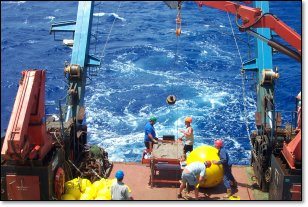1 December 2005
Could the Atlantic current switch off?
The Atlantic circulation largely responsible for Europe’s temperate climate slowed by nearly one third since 1957, say scientists from the National Oceanography Centre, Southampton.
The research, published in the science journal Nature on 1 December, supports computer model predictions that greenhouse gas emissions would cause this major circulation to change.
The lead author, Professor Harry Bryden, said, ‘In previous studies over
the last 50 years the overturning circulation and heat transport at this
latitude were reasonably constant. We were surprised that the circulation in
2004 was so different from previous estimates.’
Professor Bryden and co-authors, Dr Stuart Cunningham and research student
Hannah Longworth, compared measurements taken in 2004 with records from
1957, 1981, 1992 and 1998, across latitude 25 degrees north. Between 1992
and 2004 the flow reduced from 20 Sverdrups to 14 Sverdrups, a drop of 30
percent. Sverdrups are a measure of ocean flow, with one Sverdrup equivalent
to one million tonnes of water a second.
Climate models predict that temperatures in the UK could drop by as much as four degrees centigrade if this current were to stop. The models show the temperature drop would occur about a decade or two after a slowdown in the circulation. ‘So, even if the circulation stops, we won’t see icebergs off the white cliffs of Dover,’ said Professor Bryden. ‘But over a relatively short period, the climate in Europe would change.’
The Atlantic Meridional overturning circulation, sometimes called the Conveyor Belt, carries warm upper waters into northern latitudes and returns cold deep waters southward across the equator. This massive circulation, that includes the Gulf Stream, transfers heat to the atmosphere equivalent to around one million power stations.
The Natural Environment Research Council is investing £20 million ‘Rapid Climate Change Programme’. As part of this programme a team of scientists, co-ordinated by researchers at the National Oceanography Centre, Southampton, set up a pilot scheme to continuously monitor overturning circulation in March 2004.
The scientists, led by Dr Stuart Cunningham, deployed an instrument array across the Atlantic at 25°N from the Saharan coast of Africa to Florida. The monitoring array involves close collaboration with American scientists at University of Miami and the National Oceanic and Atmospheric Admistration’s (NOAA) Atlantic Oceanographic and Meteorological Laboratory. This five year pilot study may pave the way for a more permanent monitoring system.

Deploying the instrument array
Scientists are cautious about these results, as so little is known about the circulation, seasonal or decadal natural variability may be to blame for some of the observed changes.
– ends –
Notes for editors
The authors:
Professor Harry Bryden has been teaching at the National Oceanography Centre, Southampton since 2000. He specialises in understanding the role of ocean heat transport in the global climate system. Professor Bryden has some 30 years experience in studying the dynamics of ocean circulation in various parts of the global ocean. He is a Fellow of the Royal Society.
Hannah Longworth is a research student at the University of Southampton’s School of Ocean and Earth Science, which is based at the National Oceanography Centre, Southampton.
Dr Stuart Cunningham researches the role of large-scale ocean circulation in the Earth’s climate system. He led the 2004 transatlantic hydrographic section as part of an ongoing Core Strategic Research Programme "Ocean Circulation and Climate" at the National Oceanography Centre and he is leading the Rapid monitoring project to monitor the Atlantic overturning circulation. In addition to studying the Atlantic, he also researches circulation in the Southern Ocean, measuring the movement of water through Drake Passage.
The National Oceanography Centre, Southampton is a joint partnership between the University of Southampton and the Natural Environment Research Council. Before a change of name on 1st May 2005, the Centre was known as the Southampton Oceanography Centre.
The Natural Environment Research Council is one of the UK's eight Research Councils. It uses a budget of about £350m a year to fund and carry out impartial scientific research in the sciences of the environment. NERC trains the next generation of independent environmental scientists. It is addressing some of the key questions facing mankind, such as global warming, renewable energy and sustainable economic development.
For more information contact:
Natural Environment Research Council
Press Office:
Marion O'Sullivan, tel: 01793 411727 or
Owen Gaffney, tel: 01793 442629 or
e-mail: pressoffice@nerc.ac.uk